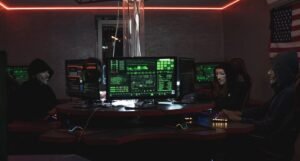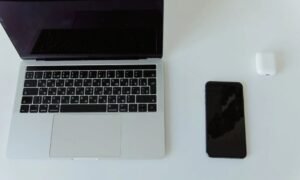Generative Art Houdini
Generative art, also known as algorithmic art, is a form of art in which artists use algorithms to generate designs, images, or animations. One of the most popular tools for creating generative art is Houdini, a powerful 3D animation and VFX software. Houdini’s procedural approach allows artists to create complex and intricate designs that would be difficult or time-consuming to create manually. In this article, we will explore the world of generative art with Houdini and discover its endless creative possibilities.
Key Takeaways:
- Houdini is a popular tool for creating generative art.
- Generative art is created using algorithms.
- Houdini’s procedural approach allows for complex and intricate designs.
One of the key advantages of Houdini for generative art is its procedural workflow. In Houdini, artists can create designs by defining a set of rules or parameters that the software follows to generate the final output. This approach allows for a high level of control and flexibility, as artists can easily modify and iterate on their designs by changing the parameters. Houdini’s procedural nature also makes it possible to create animations and variations of the design with minimal effort.
*Houdini’s procedural workflow enables artists to define rules and parameters for generating designs, providing flexibility and control over the creative process.
Another important feature of Houdini for generative art is its node-based interface. Houdini uses a visual programming language called “VEX” that allows artists to create complex designs by connecting nodes together. Each node represents a specific operation or function, such as generating geometry, applying deformations, or creating patterns. By combining and manipulating these nodes, artists can create intricate and detailed designs. The node-based interface also makes it easy to experiment with different design ideas and quickly iterate on the artwork.
*Houdini’s node-based interface using VEX enables artists to create intricate designs by connecting nodes together, facilitating experimentation and iteration.
In addition to its procedural workflow and node-based interface, Houdini offers a wide range of tools and effects specifically designed for generative art. These tools include various noise and pattern generators, fractal algorithms, particle systems, and physics simulations. Artists can use these tools to add complexity and randomness to their designs, resulting in unique and captivating artwork. Houdini also supports scripting languages like Python and HScript, allowing artists to further customize and automate their generative art workflows.
*Houdini provides a vast array of tools and effects designed for generative art, including noise generators, fractal algorithms, particle systems, and physics simulations, enabling artists to add complexity and uniqueness to their designs.
Tables:
| Tool | Description |
|---|---|
| Noise Generator | Generate procedural noise patterns for texture and geometry. |
| Fractal Algorithm | Create intricate and self-similar patterns such as Mandelbrot sets. |
| Particle System | Simulate the behavior and movement of particles for dynamic effects. |
| Feature | Description |
|---|---|
| Node-Based Interface | Create complex designs by connecting nodes together. |
| Pattern Generators | Generate various patterns like cellular automata or Voronoi diagrams. |
| Physics Simulations | Simulate the motion and interaction of objects in the artwork. |
| Scripting Language | Description |
|---|---|
| Python | Customize and automate generative art workflows. |
| HScript | Write scripts to control and manipulate the artwork. |
| VEX | Visual programming language for creating complex designs. |
Houdini has gained popularity among artists and designers for its ability to create stunning generative art. Its procedural workflow, node-based interface, and wide range of tools and effects provide artists with the flexibility and control they need to bring their creative vision to life. Whether you are an experienced artist or just starting your journey into generative art, Houdini is a tool worth exploring. So unleash your creativity and dive into the world of generative art with Houdini!

Common Misconceptions
Generative Art Houdini
One common misconception about Generative Art Houdini is that it requires advanced coding skills. While it is true that Houdini offers powerful scripting capabilities, it is not necessary to be a coding expert to create generative art with this software. Many of the generators and effects in Houdini can be implemented through its visual node-based interface, allowing artists to create intricate and complex designs without writing a single line of code.
- Houdini’s node-based interface makes creating generative art accessible to non-coders.
- While coding skills can enhance the possibilities, they are not a requirement to create stunning generative art in Houdini.
- Houdini’s user-friendly interface allows artists to focus on the creative process without getting caught up in technical programming details.
Another misconception is that Generative Art Houdini is limited to creating abstract designs. While Houdini excels in generating abstract and organic patterns, it is capable of producing a wide range of visual styles. With the right skill set and knowledge, artists can use Houdini to create realistic simulations, architectural visualizations, and even character animations. Its versatility enables artists to explore various artistic concepts and styles through generative art.
- Houdini can be used to create realistic simulations, such as water or fire effects.
- Generative Art Houdini is not limited to abstract designs; it can produce architectural visualizations and character animations.
- The software’s versatility allows artists to push the boundaries of generative art and explore different visual styles.
Some people mistakenly believe that Generative Art Houdini is only suitable for experienced artists or professionals. While Houdini is indeed utilized by professionals in industries like film and gaming, it is a tool that can be accessible to artists of all skill levels. There are various learning resources, tutorials, and communities dedicated to helping beginners get started with Houdini and learn the fundamentals of generative art.
- Generative Art Houdini can be learned by artists of all skill levels, not just professionals.
- There are ample learning resources and tutorials available to beginners looking to start their journey with Houdini.
- Houdini’s user-friendly interface and community support make it accessible to artists getting started in generative art.
A common misconception is that Generative Art Houdini is a time-consuming process. While creating intricate generative art can indeed take time and experimentation, Houdini offers features like proceduralism and automation that can significantly speed up the art creation process. Artists can utilize pre-built nodes, presets, and procedural workflows to generate complex designs efficiently and iterate on their ideas more rapidly.
- Houdini’s procedural workflow and automation capabilities can save time in the generative art creation process.
- Pre-built nodes and presets allow artists to quickly generate complex designs without starting from scratch.
- Rapid iteration is possible in Houdini, enabling artists to experiment with different variations of their generative art.
Lastly, there is a misconception that Generative Art Houdini is solely focused on visual art. While its primary application is in visual art, Houdini is not limited to just creating images or animations. It can also seamlessly integrate with other creative disciplines like sound and music. Artists can use Houdini to generate soundscapes, create music visualizations, or even create interactive audiovisual experiences through its integration with programming frameworks.
- Houdini can be used to generate soundscapes and create interactive audiovisual experiences.
- Generative Art Houdini is not confined to visual art; it can seamlessly integrate with sound and music to create immersive experiences.
- Through its integration with programming frameworks, Houdini enables the creation of music visualizations and interactive installations.

The History of Generative Art
Generative art is a form of art created using an autonomous system or a set of rules. Its roots can be traced back to the mid-20th century, when artists, mathematicians, and computer scientists started experimenting with the concept. Here are 10 significant moments in the history of generative art:
Artists Inspired by Mathematics
Throughout history, many artists have found inspiration in the mathematical principles that underlie the natural world. Here are 10 notable artists who incorporated mathematical concepts into their artwork:
Generative Art Exhibitions
Exhibitions dedicated to generative art have provided a platform for artists to showcase their innovative work. These exhibitions offer visitors the opportunity to explore the creative potential of algorithmically generated art. Here are 10 noteworthy generative art exhibitions:
Evolution of Generative Art Software
As generative art gained popularity, software tools were developed to facilitate the creation process. New software solutions enable artists to experiment with a wide range of algorithms and generate intricate visuals. Here are 10 influential generative art software releases:
Artists Pushing Boundaries with Generative Art
Many contemporary artists are pushing the boundaries of generative art, exploring new techniques and concepts. Here are 10 artists who are at the forefront of the generative art movement:
Generative Art Installations
Generative art installations captivate viewers by creating immersive and interactive experiences. These installations often combine technology, visual elements, and sound to engage the audience and evoke emotions. Here are 10 remarkable generative art installations:
Generative Art in Commercial Applications
Generative art has found its way into various commercial applications, including advertising, product design, and fashion. These innovative uses of generative art bring a fresh and dynamic approach to traditional marketing and design practices. Here are 10 examples of generative art in commercial applications:
Generative Art in Public Spaces
Generative art has also found a home in public spaces, enriching urban landscapes with its dynamic and ever-changing nature. These public installations inspire curiosity and encourage contemplation, creating memorable experiences for passersby. Here are 10 remarkable examples of generative art in public spaces:
Generative Art and Artificial Intelligence
The integration of generative art and artificial intelligence has opened up new possibilities for creative expression. Through the use of machine learning algorithms, artists can create artwork that evolves and responds dynamically to input or changes in its environment. Here are 10 fascinating projects at the intersection of generative art and artificial intelligence:
The Future of Generative Art
Generative art continues to evolve as technology advances and artists push the boundaries of creativity. The future holds exciting possibilities for generative art, as it becomes more accessible, interactive, and integrated into various aspects of our lives. As we embark on this artistic journey, we can eagerly anticipate the unexpected and extraordinary creations yet to come.
Frequently Asked Questions
What is generative art?
Generative art is a form of art in which artists use algorithms or systems to generate artworks. These algorithms or systems create unique and unpredictable visual or audio outputs, often incorporating randomness or user input.
What is Houdini in the context of generative art?
Houdini is a powerful procedural generation software often used in the field of computer graphics. It provides tools and capabilities for artists to create complex and realistic visual effects, simulations, and animations.
How does Houdini enable generative art creation?
Houdini allows artists to create procedurally generated content by using nodes and networks. Artists can define relationships between nodes to generate patterns, textures, animations, or simulations in a non-linear and flexible manner.
What are some common techniques used in generative art with Houdini?
Some common techniques used in generative art with Houdini include fractal generation, particle systems, procedural modeling, fluid simulations, noise functions, and more. These techniques enable artists to design and manipulate complex visual elements.
Are there any resources or tutorials available for learning generative art with Houdini?
Yes, there are various online resources and tutorials available for learning generative art with Houdini. These resources can be found on websites, forums, YouTube channels, and Houdini-specific learning platforms.
Can generative art created in Houdini be exported for use in other applications?
Yes, generative art created in Houdini can be exported in various file formats such as images, videos, 3D models, or even custom data formats. These exported assets can then be used in other applications or integrated into larger creative projects.
Is programming knowledge required to create generative art with Houdini?
Having basic programming knowledge can be beneficial when creating generative art with Houdini as it allows artists to have more control and flexibility over their creations. However, Houdini also provides visual programming tools and a node-based interface, making it accessible to artists with or without extensive programming experience.
Can generative art created in Houdini be interactive?
Yes, generative art created in Houdini can be made interactive. Through the use of user input, parameters, and scripting, artists can create generative artworks that respond to user actions or manipulate their output based on real-time interactions.
Is generative art created in Houdini suitable for printing or physical artwork?
Absolutely! Generative art created in Houdini can be printed or used as a basis for physical artwork. Artists can export high-resolution images or 3D models from Houdini, which can then be printed, framed, or transformed into physical installations using various techniques such as CNC milling or 3D printing.
Can generative art created in Houdini be used commercially?
Yes, generative art created in Houdini can be used commercially. Artists can sell or license their generative artworks for various purposes, including advertisements, product design, digital media, and more. However, it is essential to review and comply with Houdini’s licensing terms and conditions.




